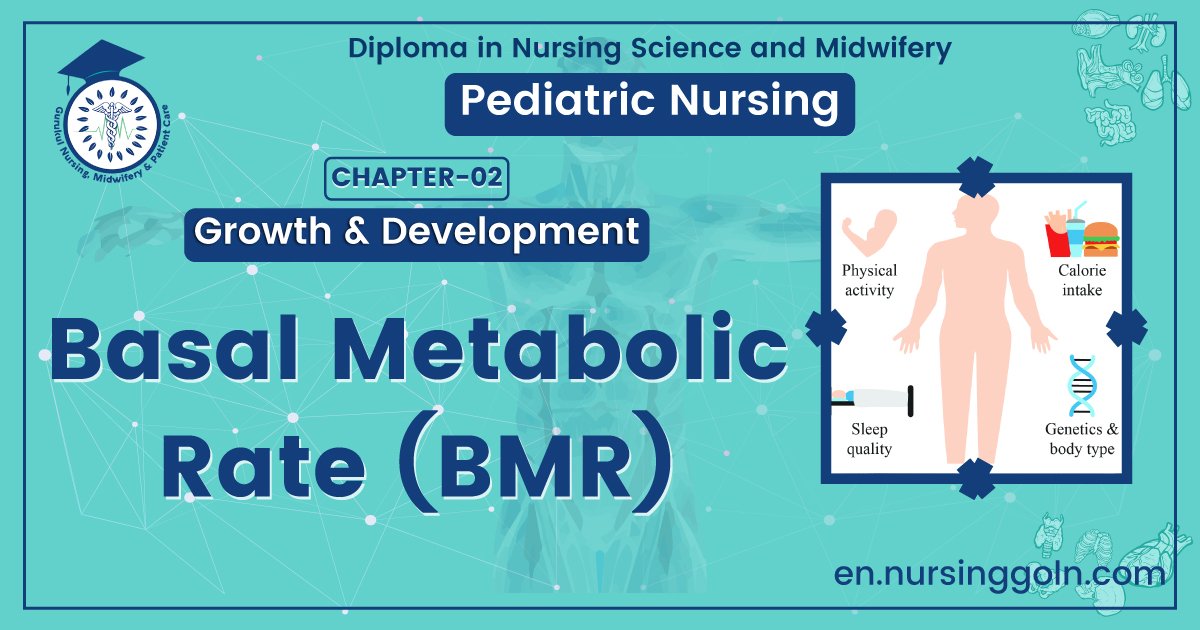Basal Metabolic Rate (BMR) – Health of the children has been considered as the vital importance to all societies because children are the basic resource for the future of humankind. Nursing care of children is concerned for both the health of the children and for the illnesses that affect their growth and development. The increasing complexity of medical and nursing science has created a need for special area of child care, i.e. pediatric nursing.
Pediatric nursing is the specialized area of nursing practice concerning the care of children during wellness and illness. It includes preventive, promotive, curative and rehabilitative care of children. It emphasizes on all round development of body, mind and spirit of the growing individual. Thus, pediatric nursing involves in giving assistance, care and support to the growing and developing children to achieve their individual potential for functioning with fullest capacity.
Basal Metabolic Rate (BMR)

Basal Metabolic Rate (BMR):
The amount of minimum energy required to carry on the basic involuntary (internal) work of the body is known as Basal Metabolic Rate (BMR).
(Ref: Sheilla John’s/1/16)
[OTHER DEFINITIONS – NICE TO KNOW]
Basal metabolic rate (BMR), and the closely related resting metabolic rate (RMR), is the amount of energy expended daily by humans and other animals at rest. Rest is defined as existing in a neutrally temperate environment while in the post-absorptive state. In plants, different considerations apply.
BMR refers to the, energy spent by a person while in a state of absolute physical and mental rest.

(Ref: Essential of Human Nutrition/1/11)
BMR is the amount of energy required by a person who is awake but he is nearly as possible as at complete mental and physical rest and has had no food for 12-24 hours. This is BMR.
(Ref: T. K. Indrani/1/2)
The Basal Metabolic Rate (BMR) is the rate at which the body uses energy for the chemical process that keeps up alive and warm and that build tissues and secrete fluid.
(Ref: Nutrition for Developing Countries/24/16)
Factors Affecting Basal Metabolic Rate:
1. Sex: Women have 6 to 10% lower basal metabolic rate when compared to men. The influence of sex hormone accounts for the difference.
2. Age: The BMR is highest during the first 2 years of life. It declines gradually throughout childhood and accelerates slightly in adolescence. The rapid growth rate explains the high metabolic rate in early childhood.
3. Sleep: During the sleeping hours the BMR is about 10% lower than in waking state.
4. Body temperature: An elevation in body temperature increases the basal metabolic by 13a/o for each degree centigrade (7% each degree Fahrenheit].
5. Endocrine glands: The thyroid gland regulates the rate of energy metabolism and any change in thyroid activity is reflected in the metabolic rate. If the thyroid is overactive (Hyperthyroidism) the metabolism may be increased to as 75 to 100% and if the activity is reduced, then the metabolism may be reduced to 30 to 40o/o. The growth hormones that stimulate new tissue formation are responsible for the higher metabolism generally observed infants, children and teenagers.
6. When the persons are severely under nourished, there is destruction of body tissue which lowers the basal metabolic rate.
7. Pregnancy: During pregnancy and lactation there is general increase in the basal metabolic rate. During the last trimester the basal metabolic rate increases from 15 to 25%o. This increase can be accounted for almost entirely by increase in the weight of women and high rate of metabolism.

8. Climate: Depending on the climatic conditions also the basal metabolism increases or decreases. The thyroid gland can adjust to the climatic changes. Their decreased basal metabolism rate in tropical climates and increased metabolic rate in colder climates.
(Ref: Molly Sam’s A text book of Nutrition for Nurses/2nd/66-68)
Read more:
